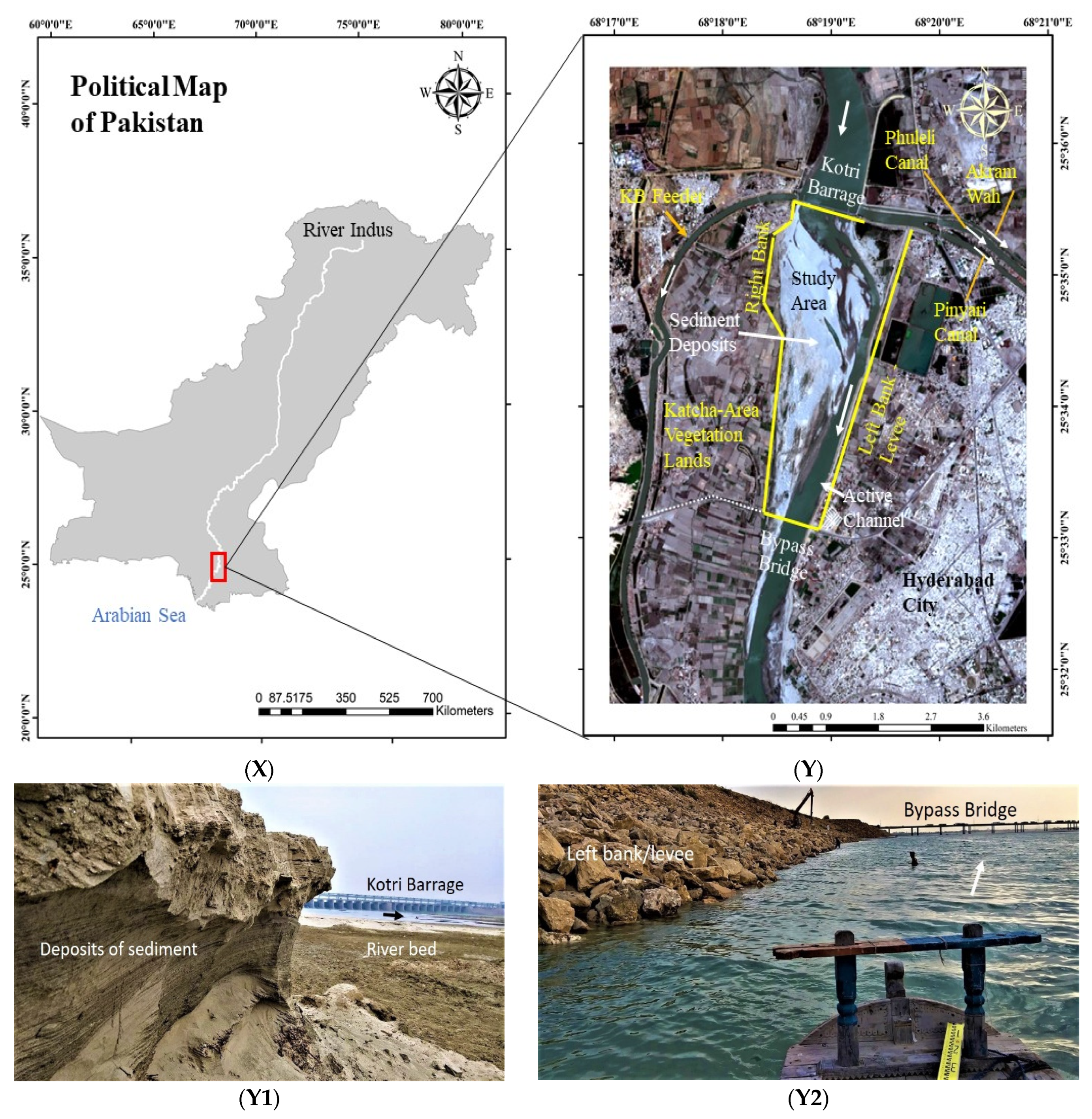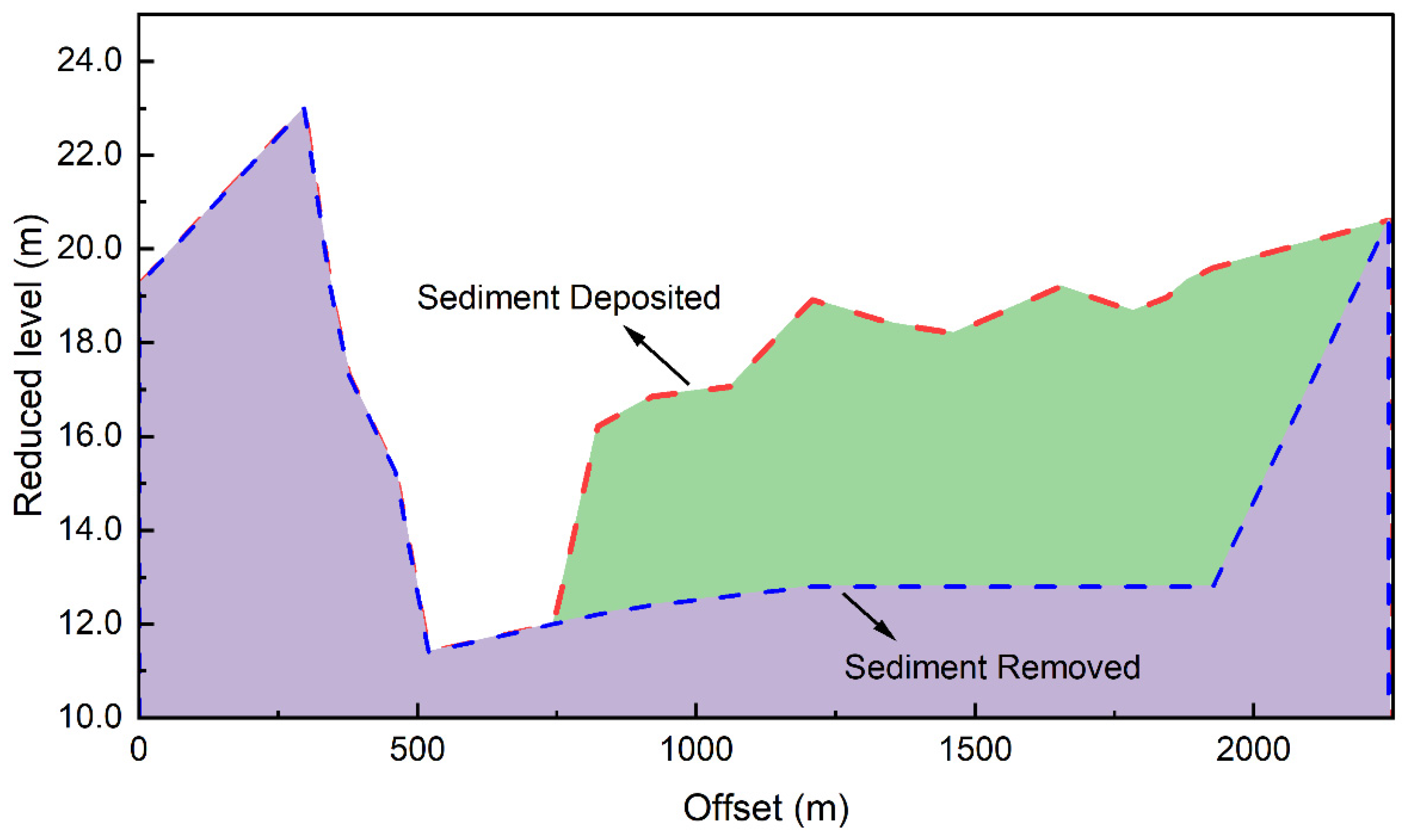Impact of Sediment Deposition on Flood Carrying Capacity of an Alluvial Channel: A Case Study of the Lower Indus Basin
Abstract
:1. Introduction
2. Materials and Methods
2.1. Study Area
2.2. Hydrologic Analysis
2.3. Landscape Analysis
2.4. Hydraulic Analysis
3. Results and Discussion
3.1. Hydrologic Analysis
3.2. Landscape Analysis
3.3. Calibration and Validation
3.4. Sediment Deposits Impact Assessment
3.5. River Geometry Optimization
4. Conclusions
Author Contributions
Funding
Data Availability Statement
Acknowledgments
Conflicts of Interest
References
- Ashmore, P.; Peirce, S.; Leduc, P. Expanding the “Active Layer”: Discussion of Church and Haschenburger (2017) What is the “Active Layer”? Water Resour. Res. 2018, 54, 1425–1427. [Google Scholar] [CrossRef] [Green Version]
- Leduc, P.; Ashmore, P.; Gardner, T. Grain sorting in the morphological active layer of a braided river physical model. Earth Surf. Dyn. Discuss. 2015, 3, 577–600. [Google Scholar] [CrossRef] [Green Version]
- Ashmore, P.; Bertoldi, W.; Tobias Gardner, J. Active width of gravel-bed braided rivers. Earth Surf. Process. Landforms 2011, 36, 1510–1521. [Google Scholar] [CrossRef]
- Alekseevskiy, N.I.; Berkovich, K.M.; Chalov, R.S. Erosion, sediment transportation and accumulation in rivers. Int. J. Sediment Res. 2008, 23, 93–105. [Google Scholar] [CrossRef]
- Ali, A. Indus Basin Floods: Mechanisms, Impacts and Management; Asian Development Bank: Mandaluyong, Philippines, 2013. [Google Scholar]
- Agro-Dev, A. Tarbela dam and related aspects of the Indus river basin systems. In WCD Case Study; International (Pvt.) Ltd.: Islamabad, Pakistan, 2000. [Google Scholar]
- Inam, A.; Khan, T.; Tabrez, A.; Amjad, S.; Danish, M.; Tabrez, S. Natural and Man Made Stresses on the Stability of Indus Deltatic Eco-Region; Geolo: Bangkok, Thailand, 2003. [Google Scholar]
- Giosan, L.; Constantinescu, S.; Clift, P.D.; Tabrez, A.R.; Danish, M.; Inam, A. Recent morphodynamics of the Indus delta shore and shelf. Cont. Shelf Res. 2006, 26, 1668–1684. [Google Scholar] [CrossRef]
- Jorgensen, D.W.; Harvey, M.D.; Schumm, S.A.; Flam, L. Morphology and Dynamics of the Indus River: Implications for the Mohen jo Daro Site; Himalaya to the Sea; Shroder, J.F.J., Ed.; Routledge: London, UK, 1993; pp. 228–326. [Google Scholar]
- Vörösmarty, C.J.; Meybeck, M.; Fekete, B.; Sharma, K.; Green, P.; Syvitski, J.P.M. Anthropogenic sediment retention: Major global impact from registered river impoundments. Glob. Planet. Chang. 2003, 39, 169–190. [Google Scholar] [CrossRef]
- Syvitski, J.P.M.; Vörösmarty, C.J.; Kettner, A.J.; Green, P. Impact of Humans on the Flux of Terrestrial Sediment to the Global Coastal Ocean. Science 2005, 308, 376–380. [Google Scholar] [CrossRef]
- Ali, K.F.; De Boer, D.H. Spatial patterns and variation of suspended sediment yield in the upper Indus River basin, northern Pakistan. J. Hydrol. 2007, 334, 368–387. [Google Scholar] [CrossRef]
- Holmes, D.A. The Recent History of the Indus. Geogr. J. 1968, 134, 367. [Google Scholar] [CrossRef]
- West Pakistan Water and Power Development Authority. Indus River Flow Data into Reservoir of Pakistan; West Pakistan Water and Power Development Authority: Lahore, Pakistan, 2017.
- Wang, Z.Y.; Lee, J.H.; Melching, C.S. Estuary Processes and Management. In River Dynamics and Integrated River Management; Springer: Berlin, Germany, 2015; pp. 467–554. [Google Scholar]
- Guo, L.; Su, N.; Zhu, C.; He, Q. How have the river discharges and sediment loads changed in the Changjiang River basin downstream of the Three Gorges Dam? J. Hydrol. 2018, 560, 259–274. [Google Scholar] [CrossRef]
- West Pakistan Water and Power Development Authority. Lower Indus Report, The Atlas; West Pakistan Water and Power Development Authority: Lahore, Pakistan, 1965.
- Boota, M.W.; Yan, C.; Idrees, M.B.; Li, Z.; Dou, M.; Zohaib, M.; Yousaf, A. Assessment of the morphological trends and sediment dynamics in the Indus River, Pakistan. J. Water Clim. Chang. 2021, 12, 3082–3098. [Google Scholar] [CrossRef]
- Ijaz, M.W.; Mahar, R.B.; Ansari, K.; Siyal, A.A.; Anjum, M.N. Integrated assessment of contemporary hydro-geomorphologic evolution of the Indus River Estuary, Pakistan in context to regulated fluvial regimes. Estuar. Coast. Shelf Sci. 2020, 236, 106657. [Google Scholar] [CrossRef]
- Singh, M.; Singh, I.B.; Müller, G. Sediment characteristics and transportation dynamics of the Ganga River. Geomorphology 2007, 86, 144–175. [Google Scholar] [CrossRef]
- Lu, H.; Burbank, D.W.; Li, Y.; Liu, Y. Late Cenozoic structural and stratigraphic evolution of the northern Chinese Tian Shan foreland. Basin Res. 2010, 22, 249–269. [Google Scholar] [CrossRef]
- Nepal, S.; Shrestha, A.B. Impact of climate change on the hydrological regime of the Indus, Ganges and Brahmaputra river basins: A review of the literature. Int. J. Water Resour. Dev. 2015, 31, 201–218. [Google Scholar] [CrossRef] [Green Version]
- Rasul, G.; Mahmood, A.; Sadiq, A.; Khan, S. Vulnerability of the Indus Delta to Climate Change in Pakistan. Pak. J. Meteorol. 2012, 8, 89–107. [Google Scholar]
- Cruff, R.W.; Rantz, S.E. A Comparison of Methods Used in Flood-Frequency Studies for Coastal Basins in California; U.S. Government Printing Office: Washington, DC, USA, 1965.
- Dalrymple, T. Flood-Frequency Analyses, Manual of Hydrology: Part 3; 1543-A; U.S. Government Publishing Office: Washington, DC, USA, 1960.
- McFeeters, S.K. The use of the Normalized Difference Water Index (NDWI) in the delineation of open water features. Int. J. Remote Sens. 1996, 17, 1425–1432. [Google Scholar] [CrossRef]
- Yang, B.; Tong, S.T.Y.; Fan, R. Using High Resolution Images from UAV and Satellite Remote Sensing for Best Management Practice Analyses. J. Environ. Inform. 2021, 37, 79–92. [Google Scholar] [CrossRef]
- Ijaz, M.W.; Siyal, A.A.; Mahar, R.B.; Ahmed, W.; Anjum, M.N. Detection of Hydromorphologic Characteristics of Indus River Estuary, Pakistan, Using Satellite and Field Data. Arab. J. Sci. Eng. 2017, 42, 2539–2558. [Google Scholar] [CrossRef]
- Tadono, T.; Ishida, H.; Oda, F.; Naito, S.; Minakawa, K.; Iwamoto, H. Precise Global DEM Generation by ALOS PRISM. ISPRS Ann. Photogramm. Remote Sens. Spat. Inf. Sci. 2014, II-4, 71–76. [Google Scholar] [CrossRef] [Green Version]
- Ijaz, M.W.; Mahar, R.B.; Ansari, K.; Siyal, A.A. Optimization of salinity intrusion control through freshwater and tidal inlet modifications for the Indus River Estuary. Estuar. Coast. Shelf Sci. 2019, 224, 51–61. [Google Scholar] [CrossRef]
- Brunner, G.W. HEC-RAS River Analysis System. Hydraulic Reference Manual. Version 4.1; U.S. Army Corps of Engineers, Hydrologic Engineering Center: Davis, CA, USA, 2010.
- Chow, V.T. Open Channel Hydraulics; McGraw-Hill Co.: New York, NY, USA, 1959. [Google Scholar]
- Simons, Li & Associates, Inc. Design Manual for Engineering Analysis of Fluvial Systems; Arizona Department of Water Resources: Phoenix, AZ, USA, 1985.
- Hu, Y.M.; Liang, Z.M.; Solomatine, D.P.; Wang, H.M.; Liu, T. Assessing the Impact of Precipitation Change on Design Annual Runoff in the Headwater Region of Yellow River, China. J. Environ. Inform. 2021, 37, 122–129. [Google Scholar] [CrossRef]











| Sr. No. | Image Acquired | Sensor | River Flow (m3/s) | Sr. No. | Image Acquired | Sensor | River Flow (m3/s) |
|---|---|---|---|---|---|---|---|
| 1 | 13/09/1990 | TM | 4123.26 | 21 | 29/04/2010 | TM | 0 |
| 2 | 31/08/1991 | TM | 3083.24 | 22 | 16/06/2010 | TM | 0 |
| 3 | 17/08/1992 | TM | 14,081.45 | 23 | 02/07/2010 | TM | 5.66 |
| 4 | 04/08/1993 | TM | 9340.40 | 24 | 19/08/2010 | TM | 8096.33 |
| 5 | 20/08/1993 | TM | 4480.33 | 25 | 04/09/2010 | TM | 20,054.80 |
| 6 | 23/08/1994 | TM | 22,549.71 | 26 | 22/10/2010 | TM | 677.29 |
| 7 | 10/10/1994 | TM | 1173.21 | 27 | 23/11/2010 | TM | 388.23 |
| 8 | 13/12/1994 | TM | 0 | 28 | 25/12/2010 | TM | 181.36 |
| 9 | 06/05/1995 | TM | 835.98 | 29 | 26/01/2011 | TM | 0 |
| 0 | 15/10/1996 | TM | 136.02 | 30 | 11/02/2011 | TM | 0 |
| 11 | 15/08/1997 | TM | 1887.35 | 31 | 31/30/2011 | TM | 0 |
| 12 | 12/05/1997 | TM | 0 | 32 | 02/05/2011 | TM | 0 |
| 13 | 18/08/1998 | TM | 3944.73 | 33 | 03/06/2011 | TM | 187.03 |
| 14 | 05/08/1999 | TM | 1825.00 | 34 | 05/07/2011 | TM | 181.36 |
| 15 | 23/08/2000 | TM | 0 | 35 | 22/08/2011 | TM | 844.49 |
| 16 | 26/08/2001 | TM | 300.38 | 36 | 14/08/2014 | OLI | 0 |
| 17 | 10/06/2002 | TM | 0 | 37 | 17/08/2015 | OLI | 16,437.38 |
| 18 | 17/09/2009 | TM | 70.84 | 38 | 19/08/2016 | OLI | 2673.06 |
| 19 | 23/01/2010 | TM | 0 | 39 | 18/03/2018 | OLI | 0 |
| 20 | 04/02/2010 | TM | 0 | ||||
| Hydrologic Years | Low | Medium | High | Very High | Exceptionally High | Average Annual Peak (1000 m3/s) | Average Volume Released (BCM) |
| Flow Velocity (1000 m3/s) | |||||||
| 8.5 | 9.9 | 14.2 | 19.8 | 25.5 | |||
| Return Period (years) | |||||||
| 1.4 | 1.8 | 4.1 | 11.5 | 33.2 | |||
| Frequency analysis | |||||||
| 1976–1985 | 04 | 02 | 01 | 01 | 01 | 10.01 | 44.27 |
| 1986–1995 | 04 | 01 | 01 | 02 | 02 | 11.57 | 58.14 |
| 1996–2005 | 08 | 02 | 00 | 00 | 00 | 4.42 | 19.81 |
| 2006–2018 | 10 | 01 | 00 | 01 | 01 | 6.86 | 19.38 |
| Hydrologic Year | Bank-Full Discharge (m3/s) | Discharge Capacity Reduction (%) | Discharge Eventuating Levee Overtop (m3/s) | Flood Carrying Capacity Reduction (%) |
|---|---|---|---|---|
| 1994 | 19,850 | - | 32,480 | - |
| 2010 | 17,600 | 11.34 | 31,100 | 4.25 |
| 2018 | 11,080 | 37.00 | 26,900 | 13.50 |
| Total | - | 48.34 | - | 17.75 |
Publisher’s Note: MDPI stays neutral with regard to jurisdictional claims in published maps and institutional affiliations. |
© 2022 by the authors. Licensee MDPI, Basel, Switzerland. This article is an open access article distributed under the terms and conditions of the Creative Commons Attribution (CC BY) license (https://creativecommons.org/licenses/by/4.0/).
Share and Cite
Mahmood, A.; Han, J.-C.; Ijaz, M.W.; Siyal, A.A.; Ahmad, M.; Yousaf, M. Impact of Sediment Deposition on Flood Carrying Capacity of an Alluvial Channel: A Case Study of the Lower Indus Basin. Water 2022, 14, 3321. https://doi.org/10.3390/w14203321
Mahmood A, Han J-C, Ijaz MW, Siyal AA, Ahmad M, Yousaf M. Impact of Sediment Deposition on Flood Carrying Capacity of an Alluvial Channel: A Case Study of the Lower Indus Basin. Water. 2022; 14(20):3321. https://doi.org/10.3390/w14203321
Chicago/Turabian StyleMahmood, Arslan, Jing-Cheng Han, Muhammad Wajid Ijaz, Altaf Ali Siyal, Muhammad Ahmad, and Maryam Yousaf. 2022. "Impact of Sediment Deposition on Flood Carrying Capacity of an Alluvial Channel: A Case Study of the Lower Indus Basin" Water 14, no. 20: 3321. https://doi.org/10.3390/w14203321
APA StyleMahmood, A., Han, J.-C., Ijaz, M. W., Siyal, A. A., Ahmad, M., & Yousaf, M. (2022). Impact of Sediment Deposition on Flood Carrying Capacity of an Alluvial Channel: A Case Study of the Lower Indus Basin. Water, 14(20), 3321. https://doi.org/10.3390/w14203321







